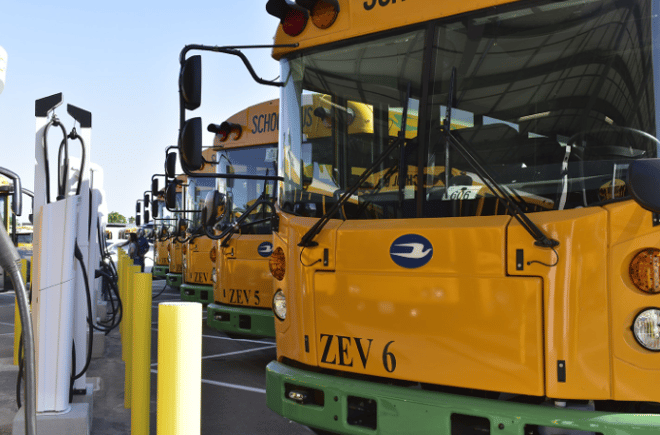Earlier this summer, we wrote about applications being open for the Clean School Bus Program. Now, the federal Environmental Protection Agency (EPA) has announced who got awarded – and school districts in Massachusetts and Rhode Island are on the list!
 GECA staff and partners with an electric school bus in Beverly, MA.
GECA staff and partners with an electric school bus in Beverly, MA.
What’s the Clean School Bus Program?
This past summer, the EPA announced its five-year, $5 billion Clean School Bus Program, funded by President Biden’s Bipartisan Infrastructure Act. The funds will go towards replacing school buses with cleaner versions across the country. In this round of funding, certain districts were designated as “prioritized.” These school districts must meet at least one of the following criteria: deemed high-need or low-income; rural; funded by the Bureau of Indian Affairs; receive basic support payments under section 7703(b)(1) of Title 20 for children residing on Indian land.
Demand Was Overwhelming
The EPA awarded almost $1 billion ($913.132 million to be exact) for clean school buses. This amount is nearly double the $500 million that was initially announced when the applications opened in the summer. More applicants are currently being considered to reach the full $965 million allocated for this round in the end. So far, 389 school districts from all 50 states (including Washington DC, federally recognized tribes, and US territories) have been awarded funding.
As the application numbers show, the demand for clean school buses was overwhelming. In this first round of funding, the EPA received around 2,000 applications requesting almost $4 billion for 12,000 school buses. For context, there are about 480,000 school buses in the nation – and right now only about 1% are electric.
 Image Source
Image Source
Electric Buses Won Big Time (That’s A Good Thing!)
Three types of “clean” buses qualified for the Clean School Bus Program: propane-, compressed natural gas (CNG)-, and electric-fueled buses. While propane and CNG buses emit significantly less nitrogen oxide (NOx) and particulate matter than their diesel equivalents, propane buses emit very similar – if not higher – levels of CO2 than diesel buses, and CNG buses are not much better.
Electric buses remain significantly cleaner and greener (even after taking into account the generation of electricity to fuel these buses). So, it’s amazing that of the 2,400 new bus purchases funded, 95% of the buses will be electric.
 Image Source
Image Source
School buses typically last over a decade and any additional fossil fuel bus purchase will perpetuate our reliance on fossil fuels, and continue to pollute our school districts and neighborhoods unnecessarily.
If you are curious about alternative fuel vehicle emissions and how they compare to regular gas and diesel vehicles, AFLEET has created a fun website to explore and compare emissions.
Massachusetts and Rhode Island Both Received Funding
Massachusetts was awarded $29.570 million in clean school bus funding, while Rhode Island received $9.875 million. Both states will receive only electric school buses, and all the receiving districts were listed as “priority districts.” So, if you live in any of the school districts listed below, be on the lookout for new electric school buses! All awardees should have their new buses by October 2024 (at the latest).
If you’re curious about other states, you can use this tool to track which districts have received funding, the amount of funding, and the number and type of buses they will have.
Massachusetts
|
School District
|
# Of Electric Buses
|
Funds
|
|
Lower Pioneer Valley Educational Collaborative
|
25
|
$9.875 million
|
|
Lawrence
|
25
|
$9.875 million
|
|
New Bedford
|
14
|
$5.530 million
|
|
Fall River
|
11
|
$3.895 million
|
|
Upper Cape Cod Regional Vocational Technical
|
1
|
$395,000
|
|
Total
|
76
|
$29.570 million
|
Rhode Island
|
School District
|
# Of Electric Buses
|
Funds
|
|
Blackstone Valley Prep A RI Mayoral Academy
|
24
|
$9.480 million
|
|
Woonsocket
|
1
|
$395,000
|
|
Total
|
25
|
$9.875 million
|
This Is Just The Start
While this EPA funding is a great start, we need to electrify all school buses. Not only will electric school buses become cleaner over time as our grid becomes cleaner, but battery storage capacities will play a crucial role in vehicle-to-grid initiatives.
Additionally, many notable school districts that applied – including Providence (a prioritized school district) – have yet to receive funding. There are a ton of waitlisted applicants across the country, including in our two states. Currently, Rhode Island is on the waitlist for $13.477 million, while school districts waitlisted in Massachusetts are cumulatively waiting for close to $1 billion of funding. A complete list of waitlisted school districts can be found here.
However, there is some more good news. The Clean School Bus Program is a five-year initiative, and this is only the first year! The EPA has announced that it will make another $1 billion available for the next round of applications in the 2023 fiscal year. We’ll be sure to post updates here when we have them!
.png?width=660&height=220&name=Match%20-%20Giving%20Tuesday%20(blog%20footer).png)



.png?width=660&height=220&name=Match%20-%20Giving%20Tuesday%20(blog%20footer).png)
Comments